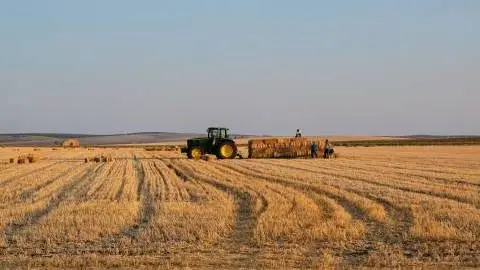Spanish food inflation is past its peak but will remain elevated
Spanish food inflation is falling but will remain high for longer than in other eurozone countries. Over the past two summers, the Spanish food sector has been hit relatively hard by unfavourable weather conditions. Consequently, the price of olive oil, which has more than doubled since the early 2020s, seems unlikely to fall back anytime soon
Spanish food inflation will continue to fall but slower than in other countries
The increase in Spanish food prices has already dropped significantly in recent months, from a peak level of 16.6% in February to 10.8% in July. There are signs that this downward movement will continue in the second half of the year.
Prices of many agricultural commodities have eased, and gas and electricity prices have fallen sharply since last summer. The selling price expectations among producers of food and non-alcoholic beverages, which are a good leading indicator for food inflation, have continued to ease over the last few months.
Food prices in the eurozone seem to have reached a plateau, but not in Spain
HICP index of food and non-alcoholic beverages up until July, January 2021 = 100

However, the cooling of food inflation is likely to unfold more slowly in Spain than in other countries. As the chart below shows, Spanish food producers are currently more inclined to raise prices than their French and German counterparts. This can be explained by local conditions. The extremely hot and dry weather in Spain has led to much lower domestic availability of ingredients such as wheat and olive oil, which mainly drives up the input costs of Spanish food producers.
In addition, the entire food production chain in the eurozone continues to face cost increases due to rising wages and fuel prices, making food transportation more expensive. Producers will continue to pass these on to the end customer over the coming months. All these factors will ensure that food inflation remains stubbornly high, hovering around 7-8% by the end of this year.
Spanish food manufacturers are still more inclined to raise prices
Expectations regarding sales prices in the months ahead, balance of survey answers

High food inflation will continue to put upward pressure on headline inflation
The contribution of food inflation to headline inflation will be higher in Spain than in other countries. Spanish food prices not only tend to cool off more slowly than in other countries, but they also have a greater weight in the overall inflation basket.
Spaniards generally spend a larger share of their income on food than other eurozone countries: food and non-alcoholic beverages weigh 22% in the inflation basket, compared with only 17% for the euro area.
Besides this direct effect, there are also stronger indirect effects. For instance, high food inflation will also trickle down to other components of the inflation basket, such as the restaurant and hotel component. This has a weight of 14% in Spain, well above the eurozone average of 8%, due to the larger tourism sector. While much of this bill will fall on foreign tourists, it does exert additional upward pressure on headline inflation.
Food has a greater weight in the Spanish inflation basket compared to the euro area
Relative weight in total inflation basket

Olive oil is almost twice as expensive as in early 2021
The prices of many staples have risen sharply since early 2021. Fruit, for example, has become 36% more expensive on average, while the price of olive oil has more than doubled since early 2020. For several food products, the sharpest price increases appear to be behind us. For example, the average price of vegetables has already fallen slightly, while the prices of sugar and butter seem to have stabilised in recent months.
However, for other products, such as olive oil, prices have accelerated recently. Spain, the largest producer of olive oil in Europe, had a poor harvest during the last campaign, and the outlook for the upcoming harvest is also poor.
Hot weather and a lack of rain also negatively affect the harvest of water-intensive crops such as fruit, which could push prices even higher in the coming months. Fruit is already much more expensive these days, especially the variants that need a lot of water such as citrus fruits, almonds, grapes and pomegranates.
Pressure on olive oil prices continues, but eases in some other categories
Evolution of Spanish consumer prices of some food products

Food prices will remain volatile over the next decade
Although the pace of price increases is starting to slow somewhat in the short term, we expect food inflation to remain more volatile in the next decade than in the previous one. Global warming and extreme weather events, such as prolonged drought, extremely high temperatures and short-lived heavy rainfall, make crop yields and quality much more volatile, temporarily drive up production costs, and can cause disruptions in agricultural supply chains.
Volatility has been further fuelled in recent months by some countries declaring export bans, due to a disappointing harvest, to slow down the rise in domestic food prices. Morocco, for instance, restricted tomato exports in February and India imposed restrictions on rice exports and a 40% export duty on onions. Although they may slow down domestic price increases, these export restrictions drive up prices even further in importing countries.
Spain is also particularly vulnerable to climate change. A recent United Nations report shows that the Mediterranean region is a climate change hotspot as it is warming 20% faster than the global average. Coastal areas in particular face increased disaster risks such as flooding and erosion, and the salinisation of river deltas and aquifers makes food production more uncertain. In agriculture and food production, both climate change adaptation and mitigation measures will be required, which will put upward pressure on food prices.
This publication has been prepared by ING solely for information purposes irrespective of a particular user's means, financial situation or investment objectives. The information does not constitute investment recommendation, and nor is it investment, legal or tax advice or an offer or solicitation to purchase or sell any financial instrument. Read more
Download
Download article
15 September 2023
Spain’s food sector under pressure from inflation and climate change This bundle contains 2 Articles